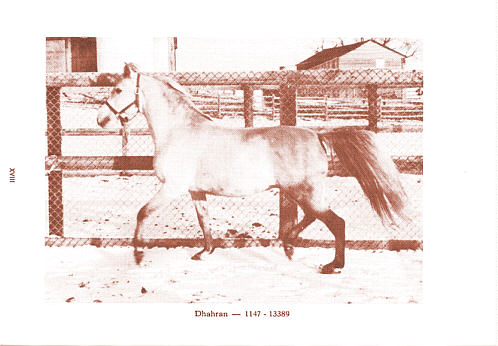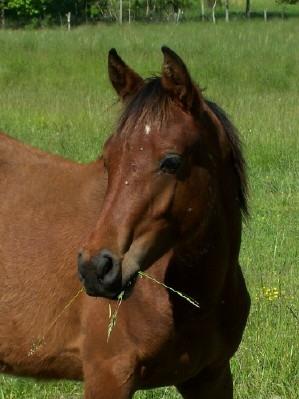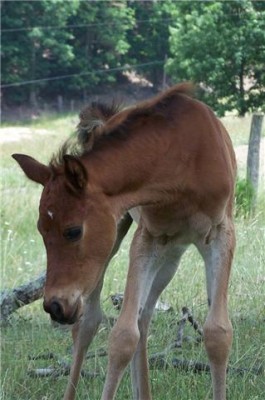Turfa: Rise, fall … and rise again?
Now if there is one Arabian mare that needs no introduction, it’s *Turfa. Ever since her importation by Henri Babson to the USA in 1941, almost seventy years ago, this pretty Kuhaylah mare has continued to embody the ideal desert-bred Arabian mare. Her famous picture trotting in the snow-covered paddocks of the Babson Farm (below) was a constant source of fascination for me, as I was growing up.

In the 1980s, asil Arabians tracing to *Turfa were a major building block of Al Khamsa, and a quick glance at one of the ads which breeders of *Turfa-bred horses placed in books like Al Khamsa Arabians (1983) suffices to convince one of the popularity of this bloodline back then. *Turfa-bred horses were athletic, had good disposition and looked like classic Arabian horses of the first order. The *Turfa blood was to be found mainly — but not exclusively — in combination with Babson Egyptian bloodlines, horses tracing to Babson lines with the addition of the stallion Sirecho (Nasr x Exochorda by Aiglon), and in many combinations within the BLUE STAR group of horses. Stallions looked especially attractive: Fa-Turf, Ibn Fadl, Dhahran (photo below, note the resemblance with his grand-dam above, he is by Sirecho out of Turfara, out of Turfa), Fa Raad (photo also below, by Fa-Turf x Raada by Ibn Fadl)


I don’t know what happened in the 1990s, but it seems like a number of foundation *Turfa breeders either retired or lost interest in the bloodline, and the number of new births among asil Arabians with at least one *Turfa cross in their pedigree plummeted, from 1234 in the 1980s decade, to 880 in the 1990s, to 428 in the 2000s. These may seem like large numbers, but they aren’t, if one considers only a tiny fraction of these numbers trace to *Turfa in the tail female (I will get you the tail female numbers soon).
However, breeders like Janet Ingram provide us with reason to believe that this sad trend can indeed be stopped. Janet was a newcomer to the world of asil Arabians when she came to own a young stallion of Babson-*Turfa bloodlines, Turfas Marine (photos above, as a colt, and as a three year old, by Sunnyru Marine out of Turfas Tara, by Princeton Faaris), who is also tail female to *Turfa. She did not know what she had, but she asked around, and quickly came to the conclusion that her stallion should not only remain a stallion, but also have the opportunity to have some offspring from related mares. Breeders like Janet Ingram need to be encouraged (someone was recently telling me that Al Khamsa needed to grow breeders as much as horses), and their sense of entreneurship and their willingness of take informed risks that would pay off later lie at the core of breeding asil Arabians on a small scale in today’s world. People like Janet Ingram are the unsung heroes of the saga of asil Arabian preservation not only in the USA but also around the world.
PS – It sounds like I am preaching, but I am not. There is a real danger of losing these horses. Really.
PPS – The mention of *Turfa’s strain, Kuhaylan, may seem innocuous, but isn’t…


WOW! Congratulations Janet. It is very nice to be connected to this colt, as his sire, Sunnyru Marine, is a son of my mare, Princeton Maarena (Serr Maariner x Princeton Gamila).
Thanks Edouard for this most wonderful article on a super mare, whose influence can still be seen in her descendants. Homer Watson once shared that of all the additional bloodlines that the Babson Farm added and then dispersed, he regretted eliminating the *Turfa program. He believed that these horses were just as good, and in some individuals, better than the Egyptian bred horses. I am a bit of a Babson-snob and Homer Watson’s interview really stunned me…”He said WHAT????” But after having met some of the *Turfa horses, I understood exactly what Homer Watson was trying to convey.
The only word of caution that I have for anyone interested in breeding for preservation is to get beyond the piece of paper and look at the horse in front of you. It has to make sense both genotypically and phenotypically, in determining whether a horse should be preserved or not. Not every horse is worthy and sometimes there is a real and valid reason why a certain bloodline becomes extinct. It doesn’t appeal to people anymore. This has nothing to do with the *Turfa horses but we really need to drive home a message of responsibility when speaking about preservation, as these are lives that are being introduced into the world and life is sacred and carries the weight of a moral responsibility. If we focus on breeding only la creme de la creme, which really is a small number of horses, than we can also boast that not only are we preserving valuable bloodlines but we are also preventing an unwanted horse problem from exploding.
Sorry for the preaching, I didn’t mean to do that but I often find this missing from these types of conversations.
Ralph
Hi, Ralph,
My problem there is that it is so hard to decide what is the “creme de la creme.” Mine might not be yours! (And nothing here says that a preservation breeder should ignore conformation, quality, athletic ability and mind.)
If we lose what is not “appeal(ing) to people anymore,” we are in danger of losing a lot of the genetic material that can keep the Bedouin horse safe for the future.
I can remember the day when Davenport horses were considered not desirable in comparison to the Skowronek-line horses that were then “appealing.” (This was back when the Babsons were not well thought of, either!) Charles was told not to bother with them, and in some pretty tough language. Thank goodness he was stubborn enough to try the bloodlines, and then follow where they led.
Jeanne
There was no mare more beautiful then Bint Turfara. As an older stallion Ibn Fadl was extreme. George Searle
and his wonderful horses were a vision, just as his ranch. The loss of the Turfa’s, a thought not thinkable.
Time will tell, as will others in the future. What were we thinging. Yet, just as we think, so we act.
Hear, hear, Jeanne!!
Jeanne, I am glad that you and Charles didn’t listen.
There are so many horses who desperately need homes today and it really weighs on my heart and mind. Who is going to provide for all of these horses?
The trouble with posting comments is that for brevity’s sake, you almost write little soundbites. If you and I and Edouard and Jenny and Jackson were all involved in a fully dimensional conversation, then I can fully explain where I am coming from. I think we all share common ground with good old fashioned common sense, Arabian type, and functional conformation. I think we would agree more than disagree.
Propably not enough common sense! why else would any of us feed a horse and risk the lack of food for self. The difficulties of wanting is the risk of losing. Yet, we do want and what better is a life held with the spell from Arabian Horses. Common sense, never, poor judgement, yes, but a life we choose.
Many groups over the years were lost, just as is with all of life. Yet, the sadness is.
I have no suggestions, other then support. Ride a Turfa,
one floats at the extended trot. Then a ride filled with adventure, the Searle kids roped bears on the ranch, fearless, but as I saw it, not much common sense! But then they as we, raised there kids on a horse.
I’m sure you’re right, Ralph! And that sounds like a gathering I would love to attend.
There, we could also discuss how to make the (several types of) Bedouin horse appealing to people today — not by changing the horses, but by changing people’s perceptions.
“Common sense, never, poor judgement, yes, but a life we choose.”
Hey! That sounds like us!!
“There, we could also discuss how to make the (several types of) Bedouin horse appealing to people today — not by changing the horses, but by changing people’s perceptions.”
And that is going to be part of the next Khamsat on our preservation project! Thanks, Jenny and Jackson!
Thank you Edouard for the wonderful article and words of encouragement. I am seeing a change in my stallion every day as he grows. He is becoming quite a handsome young man and the famous Babson temperment is there as well. He is a joy to watch and handle and I can feel a growing attachment to me on his part too. This is something that I wish all horse owners could feel. It is truely a blessing. I hope to become more active in the preservation of these wonderful horses in the future and am looking for tail female *Turfa mares and other Bedouin bred mares to complement my stallion.
Janet Ingram
The very idea, save Turfa, must be something different with her line! She is not part of a certain group as to country, as away from Arabia and the Bedouin. How come there are not more of her kind, besides she has two pedigrees. Babson got rid, so did the Otts. Unlike Fadl she is not from Egypt, Sirecho was a steach. Oh well, if you want to breed them, expect what, performance, gentle, and extreme beauty. Come to think of it what else is there?
Sounds like your horse, well oddly, this does describe
the Bedouin’s horse. Worth breeding on, try riding one of these animals.
Certainly more fun then a bike, at least for me. The only problem is you have to feed even an Arabian Horse.
Oh well, who cares except the horse. Oh yes, I care, how about the rest of you. Sure you do, I know that!
Janet Ingram does! I am sure, Edouard does. So Jeanne write the articles, just name the real source, forget to remember the other breeders in between. Gee, that sounds like fun, then every one would have to read others adds to see the difference. Only to find out there is none. Except the family names, like smith, and whatever.
Hallo, I follow this wonderful blog for some weeks now. As a breeder of Straight Egyptians in Germany interested in Arabians since my Youth (over 30 years) Your information and thoughts give me a lot of input for my thoughts. I married into a well known family of breeders, my wife is a daughter of the late Günter W. Seidlitz, breeder of Messaoud and others by Madkour and Maymoonah. The Seidlitz family tries to preserve the line of Dahman Shahwan horses they now breed for more than 30 years. Even with a greater number of horses within the Egyptians we find it very difficult to preserve this certain line and and type of our horses. Some breeding decisions help and some don´t. So I wonder, if You can preserve such old lines like that of Turfa. For sure You have to do a certain amount of inbreeding. And with Turfa, you just cannot separate her from the Babson lines. I know some Turfa horses back in the 1970s with Dr. Olms in Germany,but their influence has been very limited in Germany even with some quite successful ones back in those days.
So my input to this discussion is: We should try to preserve such lines and if we have an outstanding tail female line like Turfa it makes sense. But You need some good horses of this line, and much better another or more similar lines to infuse.
We have to work together and we need a market for our horses. We must reach the financial strong market in the Middle East with our preservation efforts. It is not only the show horse but the true Beduin horse that is the cultural heritage of the Beduins!
Congratulations Janet! I’m so glad to have met you and I very glad my grandparents could give you enough beginning info on your boy to push you in the right direction 🙂 I have grown up a HUGE fan of the Babson lines thanks to Serr Fadamaar and still incorporate them into my program as they are an invaluable source of substance and movement. I look forward to seeing your boy mature and come into his own as a sire. If you need anything, we’re here for you! Congrats again!
Maybe of interest to you, we’ve in Germany a litte stud, which is breeding with arabians based on the Blue list mares Faziza, Shar Zarqa and Shar Duda.
http://www.el-kadir.de/website/index.html
(The website is only in German, but enjoy the photos).
Stephan
I am so happy these lines are being bred! Thank you!
Dear Mathias, thank you for your message. I agree with every word you say, and we seem to think alike. I am sorry I did not get back to your private message yet, but I will over the next few days. These are rather busy times at work, but I will get back to you and in detail. Edouard
To Janet Ingram,
You will find all the encouragement you need an d more from many of the readers of this website, and from the organization Al Khamsa (www.alkhamsa.org) and other like-minded ones.
Thank you to everyone who has written. BELIEVE ME I NEED ALL THE HELP AND ENCOURAGEMENT I CAN GET. I am learning more every day and find these lines to be facinating to say the least. All of this history… If I can in some small way help to preserve a rare thing of beauty it is an honor, not a chore. It’s not work if you love doing it. I think there are others like me out there who just need to become better informed. I have loved Arabian horses for years and didn’t know anything about all the different strains. I’ve learned what little I know since I met Turfas Marine.
Janet Ingram, Can you contact me regarding your stallion, Turfas Marine? I have a mare with some similarities. I would like to discuss the possibilty of breeding her. Thanks, Wendy Clark
I am really glad Janet is doing so well with “Flick” (Turfas Marine) she bought Flick from me as a two-three year old. I own his dam Turfas Tara. She is now 27 years old and has had another colt and a filly for me. The colt Turfas Fable was sold and we lost connection with the new owners. I hope he is doing well and they kept him a stallion. Her daughter is still with me but may be going to Germany to a breeder of Al Khamsa/*Turfa lines. These horses are simply wonderful. Tara can be let out without halter and just leads simply by her neck. I wish Janet the best of luck with Flick and hope that I will have a filly or two to breed to him in the future.
It’s wonderful news Sarah, I hope you can get one more filly from her… from a Turfa related stallion.. You know there is Ibn El Iat with Elta Cook, a Fadl Turfa Sirecho stallion…
Sadly Janet sold Flick and he ended up in a rescue. He was gelded. He has an AK daughter out in the world somewhere. His sister Bint Turfas Tara is coming back home to me. I am hoping to find tail female Turfa stallions to create a small group to try and keep them going. Turfas Tara was a favorite of mine. Sadly at the time I did not realize what I had.